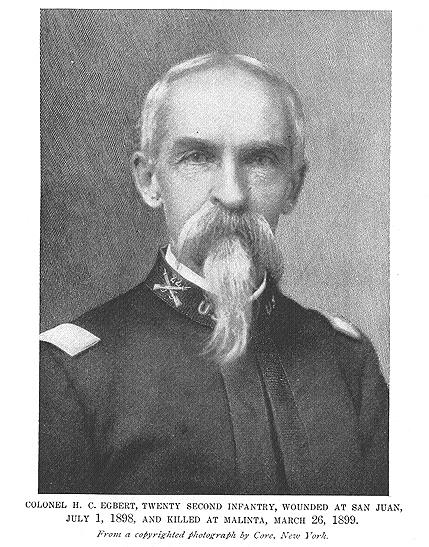 1
1
 1
1
Harry Clay Egbert
Commanding Officer 22nd Infantry
July 1, 1898 - March 26, 1899
The Official Army Registers give the following record of Harry C. Egbert's military service:
He was offered a commission as a
1st Lieutenant in the 12th US Infantry on September 23, 1861,
which he accepted on September 24. He received a Brevet promotion
to on Major August 1, 1864.
He was promoted to Captain of the 12th Infantry on April 1, 1865.
He commanded B Company 12th Infantry from 1879-1890.
Egbert was promoted to Major of
the 17th Infantry on April 23, 1890. On May 18, 1893 he was
promoted to Lieutenant Colonel of the 6th Infantry.
On July 1, 1898 he was
officially promoted and assigned as Colonel of the 22nd Infantry
(Ed., This is the same day he was wounded while commanding the
6th Infantry.)
On October 1, 1898 he was
appointed Brigadier General of Volunteers, a position which he
accepted
on October 8. On December 1, 1898 he was honorably discharged
from the Volunteers.
(Ed., The Returns of the 22nd
Infantry indicate that Egbert was absent on sick leave
recovering from his wounds until January 20, 1899 at which time
he joined the
22nd Infantry at Fort Crook, Nebraska and assumed command of the
Regiment.)
He was killed in action at Malinta, Philippine Islands, on March 26, 1899.
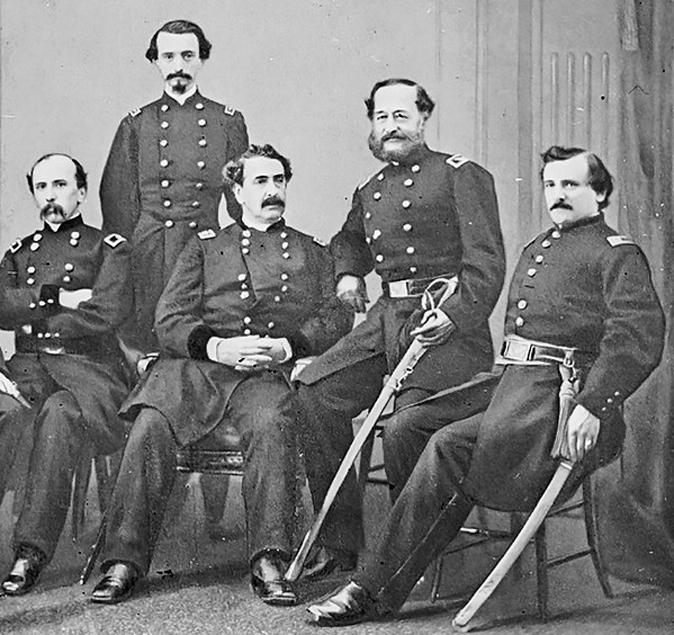
A section of a
photograph by Matthew Brady entitled "Gen. Abner Doubleday
and staff of six".
1st Lieutenant Harry C. Egbert is in the rear, standing.
U.S. National Archives’
Local Identifier: 111-B-3516
From:: Series: Mathew Brady Photographs of Civil War-Era
Personalities and Scenes, (Record Group 111)
Courtesy of Bradley M. Forbush
Battle of Cedar Mountain Foundation
A more detailed account of Egbert's military service is found in Powell's Records of Living Officers:
Born in Pennsylvania January 3, 1839.
Actual Rank ---
1st Lieutenant 12th Infantry September 23, 1861, accepted September 24, 1861
Captain April 1, 1865
Major 17th Infantry April 23, 1890
Lieutenant Colonel 6th Infantry May 18, 1893
Colonel 22nd Infantry July 1, 1898
Brigadier General Volunteers, October 1, 1898, to December 1, 1898
Brevet rank ---
Brevet Captain August 1, 1864, for gallant services at the battle of North Anna, Virginia
Brevet Major U.S.A. August 1, 1864, for gallant and meritorious services at the battle of Bethesda Church, Virginia
Honorably mentioned ---
In the "Records of the
Rebellion", in the reports of Generals Doubleday and Newton
on the battle of
Gettysburg, Pennsylvania, series I, Vol. XXVII, part 1,
pp.256-263
Service ---
In the field during the Civil War, 1861-1865
Commissary of Musters 1st Corps, Army of the Potomac, March 1863
on Inspection duty in the state of Illinois
at Georgetown, South Carolina, 1868
Montgomery, Alabama, 1868-1869
at various posts and in the field in California and Arizona from 1869 to 1882
at Fort Sully, South Dakota 1890
Staff positions occupied ---
Adjutant 2d Battalion 12th Infantry, March 1862
Battles, skirmishes, etc. ---
Engaged at the battle of Cedar Mountain, captured and confined in Libby Prison
exchanged November 1862
engaged at the battle of Fredericksburg
engaged at the battles of Rappahannock Station, Chancellorsville, Virginia, and Gettysburg, Pennsylvania
captured by rebels, and escaped
engaged in the operations at
Mine Run, battles of the Wilderness, Laurel Hill, Spottsylvania,
North Anna,
and Bethesda Church, Virginia (wounded)
Commands held ---
At Georgetown, South Carolina, commanding post 1868
commanding post of Montgomery, Alabama 1868-1869
commanding post of Camp Independence, California 1869-1873
commanding post of Fort Yuma, California 1874-1875
commanding battalion 12th Infantry in Nez Perces campaign 1877
commanding post of Benicia Barracks, California 1877-1878
commanding battalion 12th Infantry in Bannock campaign 1878
commanding post of Fort Verde, Arizona 1878-1880
at Fort Sully, South Dakota 1889
History ---
Member of the Philadelphia Bar, 1860
son of Medical Director Daniel Egbert, U.S.N., and
grandson of Colonel Richard Dennis, 18th Infantry in 1815
Killed in action at Malinta, Philippine Islands, March 26, 1899 2
In March, 1899 the 22nd Infantry
under Egbert's command arrived in the Philippines and was
immediately sent into action.
The Regiment became part of the 3rd Brigade of the 1st Division
of 8th Corps in the expedition to capture and secure the seat
of Filipino government at Malalos. The Brigade Commander was
Brigadier General Loyd Wheaton. Wheaton was tasked
with the capture of Malinta, the third in a series of towns on
the road to Malalos. He sent the 22nd Infantry forward to attack
Malinta.
The description of Egbert being
killed while leading a bayonet charge has been portrayed in
several accounts of his death.
Captain Jacob Kreps, Commander of M Company 22nd Infantry during
the battle of Malinta wrote in his diary:
"The
battle raged for twenty minutes, then Egbert led a bayonet
charge----routing the enemy.
The colonel was killed in the victorious assault." 3
That portrayal also appears to
be confirmed by the after-action report from Egbert's Commander,
Brigadier General Loyd Wheaton.
Wheaton commanded Third Brigade,
1st Division, Eighth Corps to which the 22nd Infantry was
assigned.
In his report he states that he directed the 22nd Infantry to
form on line and "charge" the enemy trenches at
Malinta.
Wheaton writes that Egbert was killed in this charge. Here is the
relevant section from Wheaton's report:
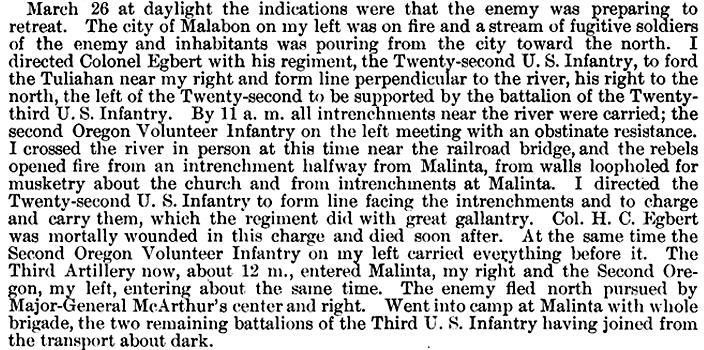
-----------------------------------------------------------------------------------------------------------------------------------------------------------------------------------4
Another descriptive account
gives a somewhat different description but still gives the
impression Egbert was killed
during an advance, or "charge":
Meanwhile the
always impatient and dashing Wheaton lost patience. The movement
was too slow for him, and he swung
his brigade rapidly into line with the rest of the army, dashing
over the tremendous network of trenches, earthworks,
leaving a large number of his men, until his brigade came in
touch with the Third Artillery, the centre of his line.
General Wheaton planted his artillery on each side of the railway
track and began the bombardment of the convent
of Malinta, used as an Insurgent fortress, preparatory to the
coming of the Twenty-second Infantry and the
never-to-be-forgotten charge of that regiment in which Colonel
Egbert lost his life.
Egbert brought
the Twenty-second across the Tuliajan River through a swampy
country. The regiment was marched
Indian file until within a short range of two Insurgent forts,
from which smoke was issuing, and figures could be seen above
the earthworks. Scouts were sent out, and ascertained that the
forts were absolutely empty; that the figures were dummies,
put there to deceive us; and that the fires were left to give the
fortifications a semblance of life. Wooden cannon were also
mounted on the ramparts. The railway line was deserted, and it
was concluded that the Insurgents had checked their
baggage farther north. So Egbert, with two hundred men, advanced
across the open field to a little hill in front of the town.
Suddenly from the church on the outskirts, seventy yards from our
men, came a terrific fire. A hasty retreat was ordered,
but hardly had the word been given when Colonel Egbert fell dead,
pierced with a Filipino bullet. Major Shields and his
orderly had their horses shot from under them, and three privates
were killed. Had the Insurgents been marksmen,
the two companies would have been wiped out. " Colonel
Egbert never asked his men to go where he would not lead,"
was the tribute of a soldier of his command, and it is worthy of
an inscription on his monument. 5
|
Left: From an article which
described the This article mentions the
advance of the 22nd Infantry The Day
newspaper of New London, Connecticut, |
Major Leo O. Parker of the 22nd
Infantry was Egbert's second in command that day and when
Egbert fell Parker assumed command of the Regiment. Since Egbert
was killed it was the responsibility
of Parker, as temporary Commander, to write the after action
report for the Regiment. He also mentions
the charge against the enemy positions by the 22nd Infantry but
indicates that Egbert was killed after
those positions were captured. Here is the relevant section from
Parker's report:

---------------------------------------------------------------------------------------------------------------------------------------------------------------------------------6
The following is a description
of the action during which COL Harry C. Egbert was killed.
The narrative is taken from a history of the 22nd Infantry
Regiment
prepared under the direction of the Regimental Adjutant,
CPT G.C. Graham, 1922:
Early in the
morning of the 26th the enemy in front of Wheaton's brigade were
in retreat.
Malabon, on the left front, was in flames; a stream of insurgent
soldiers and natives of the country
was pouring north. The 22nd marched a short distance to the right
of where it had bivouacked,
received the fire of the insurgents' rear guard, forded the
Tuliahan river, and formed line perpendicular to the river
in order to flank the enemy's trenches. Advancing to the
railroad, these trenches were found deserted.
The regiment changed front to the north; the first battalion
moved forward to scout toward Malinta.
On commanding ground, 800 yards south of Malinta, the insurgents
were strongly intrenched;
these works were charged and captured. Five hundred yards beyond
was a stone church;
a breast-high stone wall surrounding the church bristled with
Mauser rifles;
here the rear guard of the retreating insurgent army hoped to
check the American advance.
The ground in front of this stronghold was a natural glacis,
broken with only a few rice paddies;
each seventy meters of the approach was marked with nipa
streamers flying from tall bamboos.
A galling fire, accurately delivered by a superior force, met the
battalion
and forced it to seek the shelter of the captured trenches and
rice paddies.
Return volleys directed at the crest of the stone wall seemed
only to increase the intensity of the insurgent fire.
Meanwhile the remainder of the regiment was racing from the rear
to assist the troops so sorely pressed.
Arriving on the line, they threw themselves on the ground, and at
once poured over the stone walls a fire so accurate
that the well-directed firing of the insurgents promptly ceased.
There was no diminution of their fire—merely less accuracy
in their aim.
During this stage of engagement, Colonel Egbert, the gallant
commander of the regiment, was mortally wounded.
For twenty minutes the fusillade from both lines continued. At
the end of that time, the insurgent fire slackened;
ten minutes later it ceased. Entering Malinta, great quantities
of loaded and empty rifle shells were found
behind the stone walls of the church; only artillery could have
forced a valiant enemy from this position.
The official Regimental history
of the 22nd Infantry and other accounts indicate that Egbert was
killed during the
exchange of gunfire between the static lines of the 22nd Infantry
and the Filipino insurgents at Malinta, which occured
after the 22nd Infantry had charged and taken a series of
trenches on the outskirts of the town.
At the time of the exchange of
gunfire which killed Egbert the 22nd Infantry was just outside of
the town
and in the surrounding rice paddies and the insurgents were
mostly in the town itself, the main body of insurgents
occupying the area around the church. Susbsequent reports show
that Egbert was mortally wounded as he stood
in the open while directing the fire of his Regiment.
Most of the above reports used
the word "charge" which was picked up by the media of
the period and
displayed in many of the accounts of the day. Egbert did lead the
charge which resulted in the capture of the
trenches before Malinta but from most accounts he was not killed
during the charge but after the charge had ended.
The following biography of Harry
C. Egbert is from the official history of the 21st Infantry
Regiment.
(According to the lineage and history system of the Army the 21st
Infantry was created in 1866 when
the 2nd Battalion 12th Infantry was re-designated as the 21st
Infantry Regiment. Thus the 21st Infantry
claims descent and history back to the 2nd Battalion of the 12th
Infantry.)
Harry C. Egbert was commissioned
an officer in the 2nd Battalion of the 12th Infantry in 1861,
as one of the original 1st Lieutenants of that Regiment after its
creation on May 4, 1861.
Since the 21st Infantry was
later created from that 2nd Battalion of the 12th
Egbert is thus considered by the 21st Infantry to also be part of
their history and heritage.
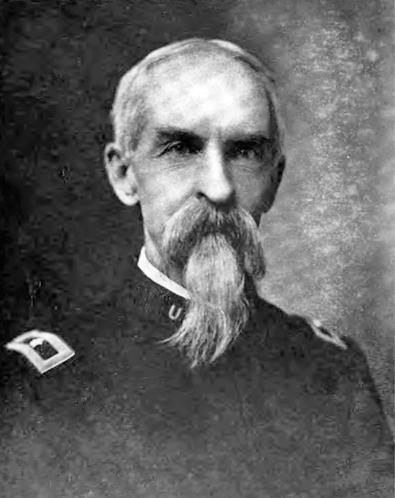 7
7
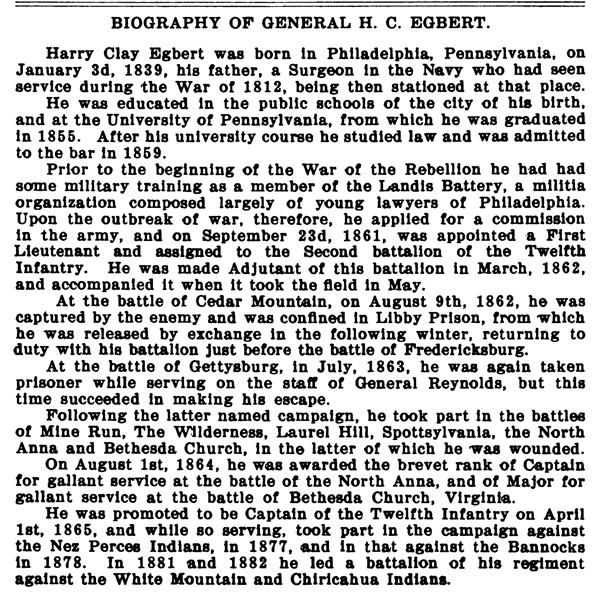
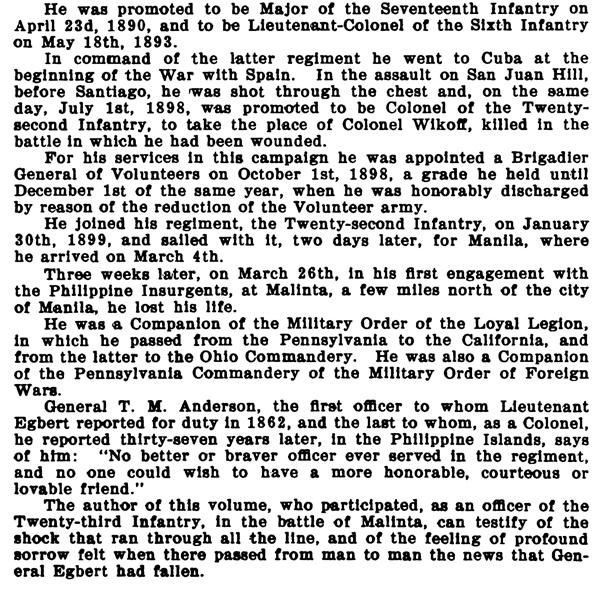
------------------------------------------------------------------------------------------------------7
**********************
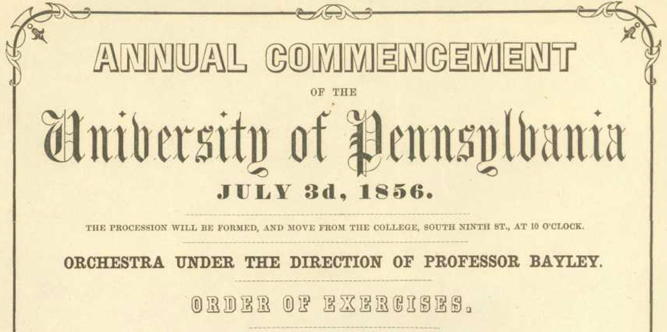

A part of the graduation ceremony
program of the University of Pennsylvania, 1856.
Harry Egbert received a degree of Bachelor of Arts. His name is
marked with a red star.
University of Pennsylvania University Archives and Records Center
**********************
As a young 1st Lieutenant with
the 12th Infantry during the Civil War Egbert reported to the
senior Captain in his Battalion,
Capt. Thomas McArthur Anderson. Thirty-seven years later when
Egbert brought the 22nd Regiment to the Philippines,
Anderson, as a Major General of Volunteers was again Egbert's
immediate superior, this time as Commander of 2nd Division,
8th Corps. In his memoir of duty with the 12th Infantry in the
Civil War Anderson wrote the following about Egbert:
When we received
our marching orders I had to select a battalion adjutant.
Fortunately I had another choice.
At that time Harry C. Egbert seemed to me not much older than a
boy. He had a youthful look and manner, yet
there was something about him which inspired confidence. When I
told him he would have to act as adjutant
he protested that he knew nothing of the duties of the position.
I told him I knew he did not, but that in the
life-and-death business we were in we had to do the best we
could. He looked very serious and answered,
"I will do my best." From that time on he did his duty
faithfully, bravely and earnestly, until, thirty-seven years
after,
he fell mortally wounded in battle in the Philippines. It seemed
a strange coincidence that I should have been
the first officer to whom he reported, and the last.
From the 12th Regiment U.S. Infantry Company A website
**********************
Immediately below are two
reports filed by Egbert as a Captain with the 12th Infantry
while serving during his long years on the frontier.
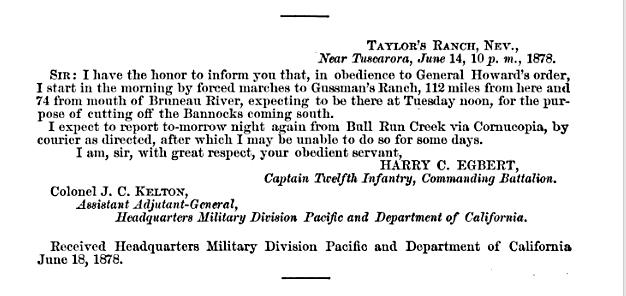
A dispatch sent by Harry Egbert, as Commander of a Battalion of the 12th Infantry during the Bannock War of 1878 8

A telegram sent by Harry Egbert, as Commander of a Battalion of the 12th Infantry during the Bannock War of 1878 8
**********************
Harry C. Egbert as a Lieutenant
Colonel assumed command of the 6th Infantry at Tampa, Florida
from April 23 to May 16, 1898
when Colonel Melville A. Cochran was assigned temporary command
of 1st Provisional Brigade. From May 16-29, 1898 Ebgert
commanded 1st Battalion 6th Infantry at Tampa.
On May 29, 1898 Egbert again
assumed command of the 6th Infantry and brought the 6th Infantry
to Cuba
aboard the transport Miami.
Egbert led the 6th Infantry in
the assault on the heights at San Juan on July 1, where, under
heavy fire during the attack
he was shot through the left lung. That same day he was
officially promoted to Colonel of the 22nd Infantry upon the
death of Colonel Charles A. Wikoff.
Egbert's official report to the
War Department, of his command of the 6th Infantry Regiment
during its assault
on San Juan heights was dated September 2, 1898 and was written
by him while he recovered from his wounds at
Fort Thomas, Kentucky. He signed it as Colonel Twenty-second
Infantry, late Lieutenant-Colonel Sixth Infantry.
To read his 4 page report, click
on the following link:
(The link is to a PDF file. To return to this page click the
"back" arrow in the PDF file.)
Report of the 6th Infantry at the battle of Santiago
**********************
More information on Harry C. Egbert:
Born at Philadelphia,
Pennsylvania, on January 3, 1839, he joined the 12th United
States Infantry
on September 23, 1861 (where he served with his brother-in-law,
William A. Dove)
and served with distinction in actions at Gaines Mills, Malvern
Hill, Cedar Mountain, Gettysburg, etc.
He was taken prisoner at Cedar Mountain and at Gettysburg, and
was seriously wounded at Bethesda Church.
He remained in the Army following the Civil War and when the
Spanish-American War broke out,
he was Lieutenant Colonel of the 6th United States Infantry,
which he commanded in the Santiago Campaign
until he was shot through the body at El Caney, Cuba, on July 1,
1898.
He was promoted to Colonel, 22nd United States Infantry, and
before his wound was completely healed,
he sailed for the Philippines. He arrived at Manila with his
command on March 4, 1899,
and while leading a bayonet charge against Insurgents received a
wound from which he died on March 26, 1899.
He is buried in Section
1 of Arlington National Cemetery, adjacent to his brother-in-law
and sister,
William A. and Julia Dove.
His wife, Ellen Young Egbert (1843-1913) is buried with him.
--------------------------------------------------------------------------------
EGBERT Avenue in San Francisco is named for Colonel Egbert,
United States army.
--------------------------------------------------------------------------------
Harry Clay Egbert of
Pennslvania
Appointed First Lieutenant, 12th United States Infantry, 23
September 1861
Captain, 1 April 1865
Major, 17th United States Infantry, 23 April 1890
Lieuenant Colonel, 6th United States Infantry, 18 May 1893
Colonel, 22nd United States Infantry, 1 July 1898
Brigadier General, United States Volunteers, 1 October 1898
Honorably discharged from Volunteer Service, 1 December 1898
Breveted Captain, 1 August 1864 for gallant service in the Battle
of North Anna, Virginia,
and Major, 1 August 1864, for gallant service in the Battle of
Bethesda Church, Virginia
Killed 26 March 1899 in action at Malinta, Philippine Islands
Also buried with Egbert is his wife:
EGBERT, ELLEN YOUNG
WIDOW OF HARRY C
DATE OF DEATH: 06/01/1913
DATE OF INTERMENT: Unknown
BURIED AT: SECTION OS/WS SITE LOT 280
ARLINGTON NATIONAL CEMETERY
WIFE OF HC EGBERT - COL 22ND US INF
Much of the above information
used with permsission,
from Arlington National Cemetery Website
http://www.arlingtoncemetery.net/
The 1st Battalion website is
grateful to Michael R. Patterson,
webmaster for the Arlington National Cemetery Website,
for the use of the above.
**********************
|
|
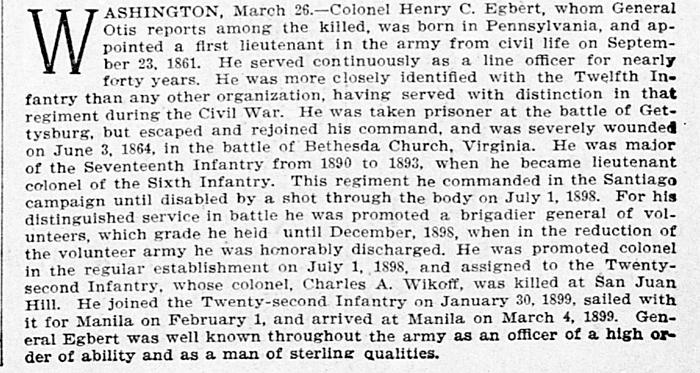
From The San Francisco Call Monday, March 27, 1899
CDNC California Digital Newspaper Collection
**********************
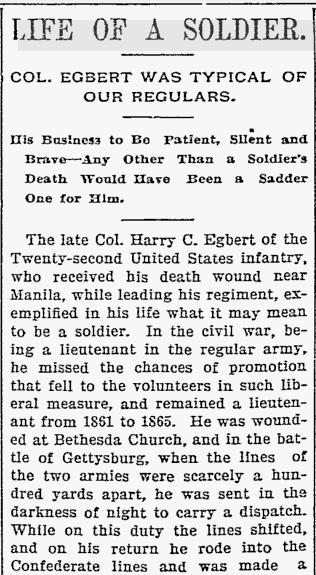
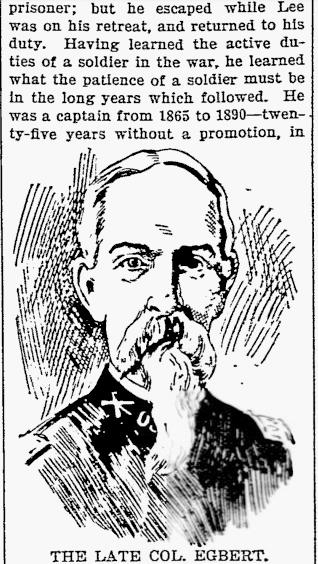
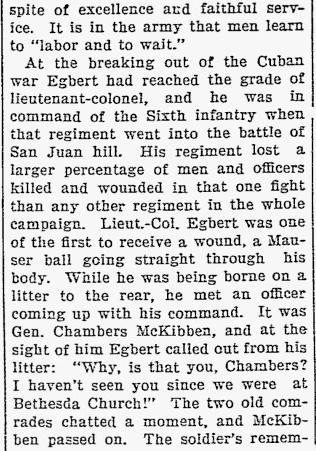
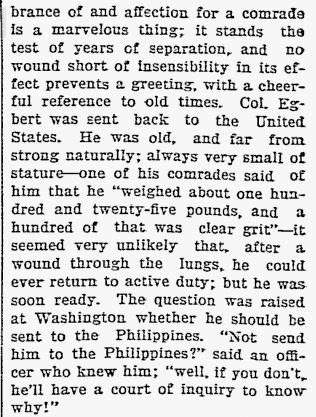
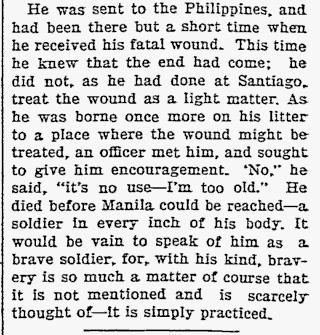
From The Daily Argus News July 22, 1899
**********************
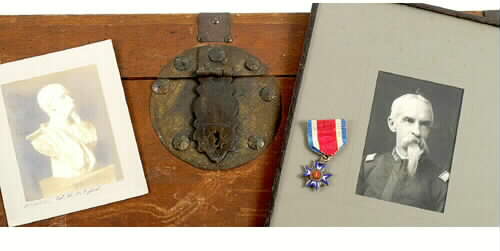
Left, a photo of a bust of Harry C. Egbert --- right, a photo of Egbert and his MOLLUS medal.
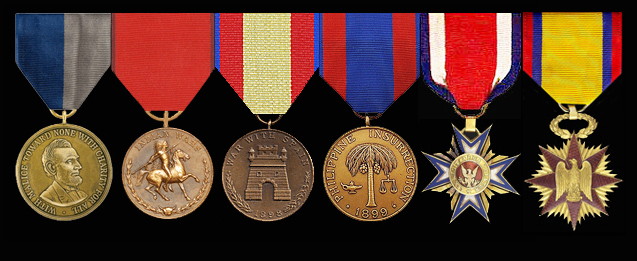
Colonel Harry Egbert's decorations
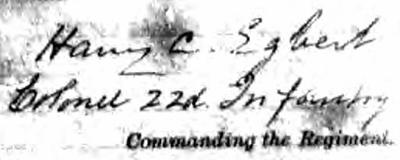
The signature of Harry C. Egbert as
Commanding Officer 22nd Infantry
on the monthly Return of the 22nd Infantry for January 1899.
|
Left: A really good photograph of Sadly an original copy of the
magazine From HARPER'S WEEKLY magazine Scan from HATHI
TRUST Digital Library |
Harry Clay Egbert is buried in Arlington National Cemetery
Section 1 Grave 280
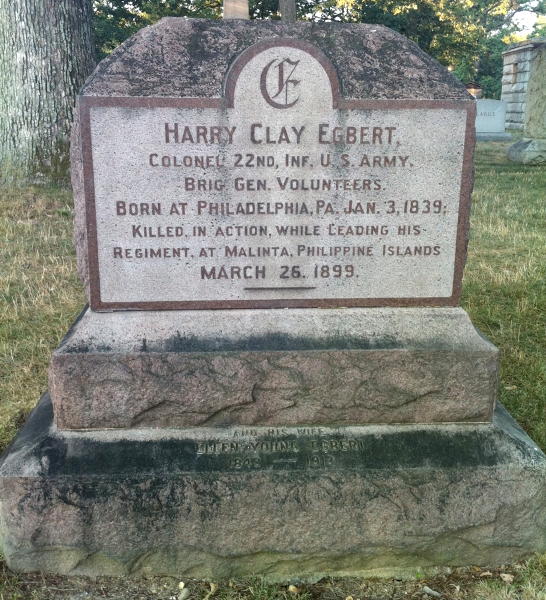
Grave monument for Harry C. Egbert
Photo from the Official Arlington National Cemetery website
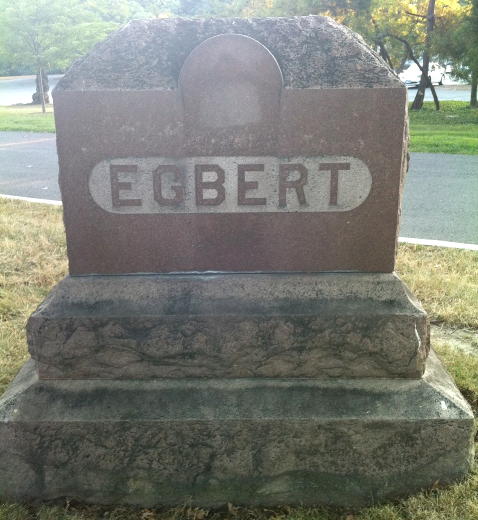
Back of the monument for Harry C. Egbert
Photo from the Official Arlington National Cemetery website
**********************
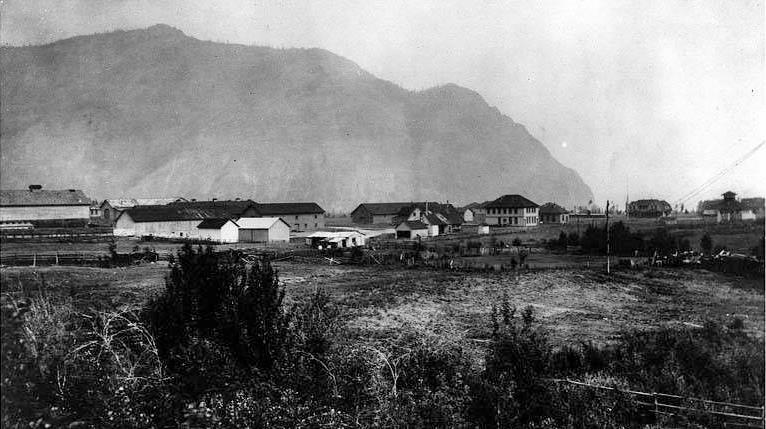
Fort Egbert, Alaska
Photo from University of Washington Digital Collections
In 1899 construction
began on a military post at Eagle, Alaska.
It was named Fort Egbert after COL H.C. Egbert.
At its height there were approximately 45 buildings erected at
the post.
It existed as a military fort until abandoned by the Army in
1911.
A detachment of the Signal Corps remained at the location,
operating the telegraph and radio station until 1925.
Only three buildings remain today and they are preserved
as a National Park Landmark.
During its service in
Alaska elements of the 22nd Infantry Regiment
were stationed at the fort named for their former Commander
during the years 1908-1910.
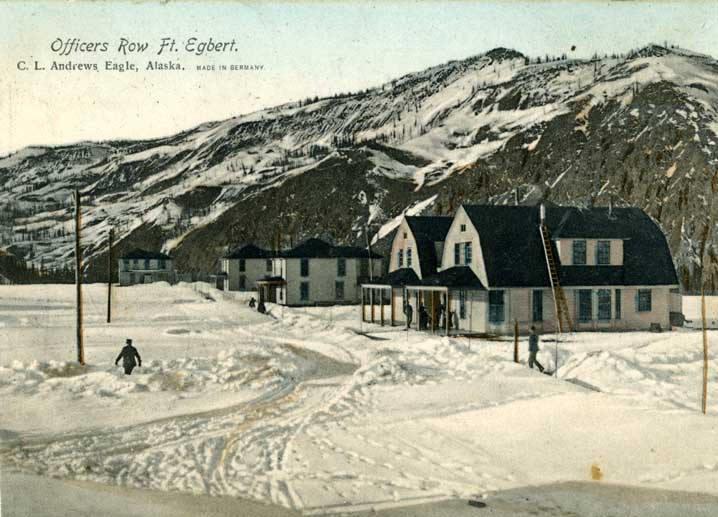
Officers' Row at Fort Egbert
from a postcard circa 1900-1911
Fort Egbert was established in
1899 during the Klondike Gold Rush, as U.S. Army headquarters in
the District of Alaska.
It was named by U.S. President William McKinley in honor of
Colonel Harry C. Egbert who died in battle on March 26, 1899 in
Manila.
The base was constructed next to Eagle Bluff, a rocky outcropping
overlooking Eagle, a Yukon River mining community near
the Canada–US border. Eagle, which was established on a
military reservation was placed under the jurisdiction of the new
base
“until such time as some form of civil government may be
established.” Eagle was released from martial law on July
23, 1900.
Fort Egbert was designated as the first station in the
Washington-Alaska Military Cable and Telegraph System (WAMCATS),
a network of telegraph lines connecting Alaska with the
contiguous United States. The first link in the system was
completed
in October 1900, running from Dawson City in the Canadian Yukon
Territory to Fort Egbert. Another link, completed August 24, 1902
connected Fort Egbert with Fort Liscum in Valdez. In 1905
Norwegian explorer Roald Amundsen used Fort Egbert's telegraph
station
to announce his successful crossing of the Northwest Passage.
Fort Egbert was abandoned in 1911 except for an Army Signal Corps
contingent which continued to operate a station until 1925,
when the wireless station (which had replaced the land lines)
burned to the ground.
Several buildings of the original Fort Egbert have been preserved
under the jurisdiction of the Bureau of Land Management.
**********************
There is a memorial
plaque for H. C. Egbert on the Stone Water Tower at Fort Thomas,
Kentucky.
Fort Thomas is on the northern bank of the Ohio River, just
across the river from Cinncinnati, Ohio.
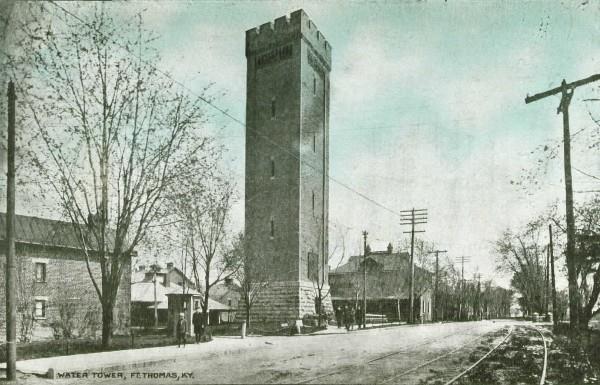
Stone Water Tower, Fort
Thomas, Kentucky
From a postcard photo taken circa 1900
The tower was
constructed in 1890 at the entrance to Fort Thomas and in that
same year
the 6th US Infantry took station at the Fort. In 1898 a bronze
plaque was mounted on the
front side of the tower, commemorating the Soldiers of the 6th
Infantry killed in Cuba.
Two Spanish cannons captured in Cuba were mounted in front of the
tower. In 1899
a smaller plaque was mounted on the side of the tower,
commemorating Colonel Harry Egbert.
The following eulogy for
Egbert is from an article in Munsey's Magazine of 1899. The
passage on
Egbert ends with the announcement of the memorial at Ft. Thomas,
to be established.
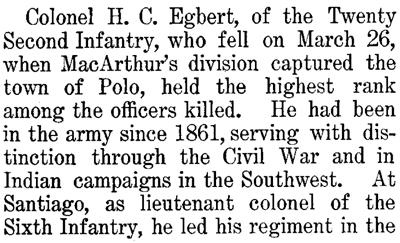
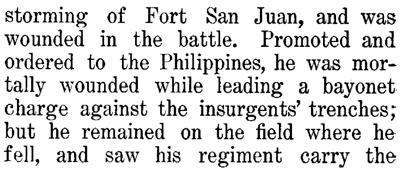
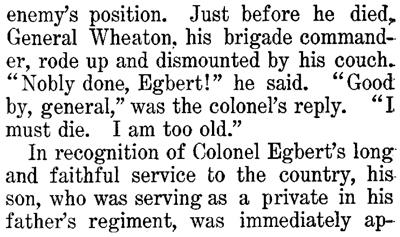



--------------------------------------------------------------------9
The following biography of Harry
C. Egbert was published by the University of Pennsylvania
and gives further detail about the plaque on the tower at Fort
Thomas. Note in the beginning
Egbert is incorrectly called "Henry" Clay Egbert, then
his name is changed to "Harry".
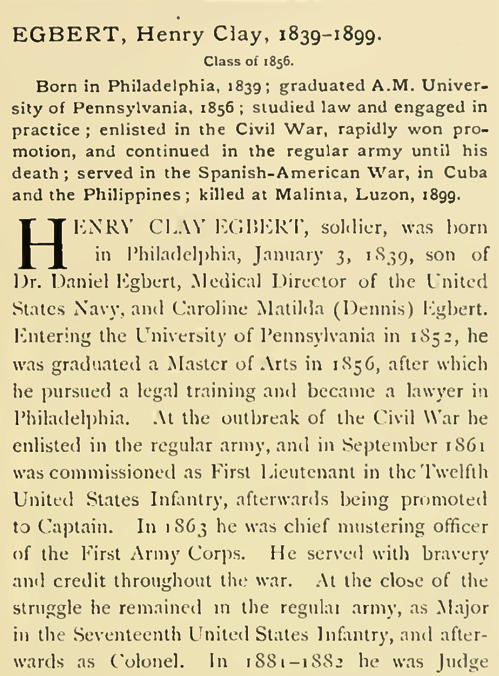
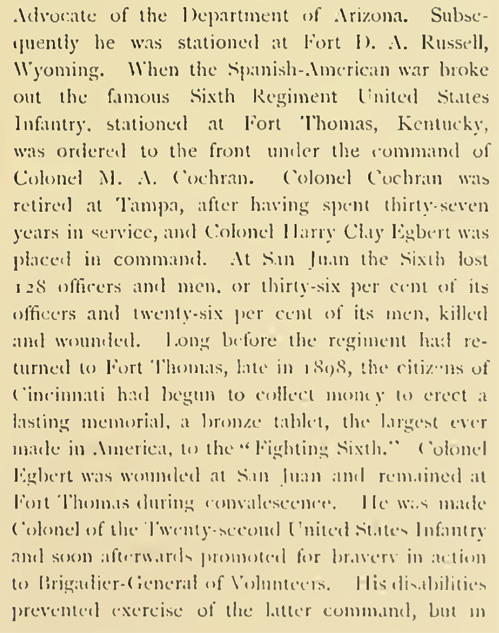
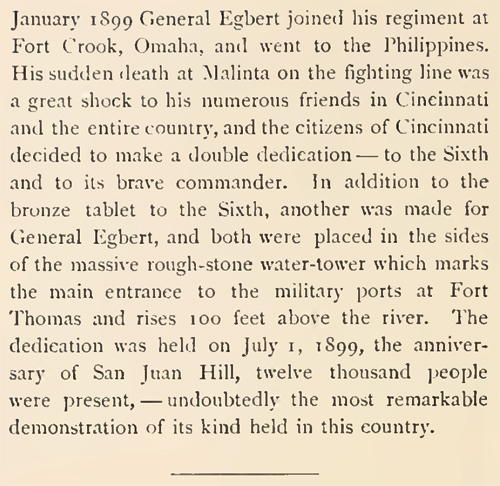
--------------------------------------------------------------------------------------------------------------------------------10
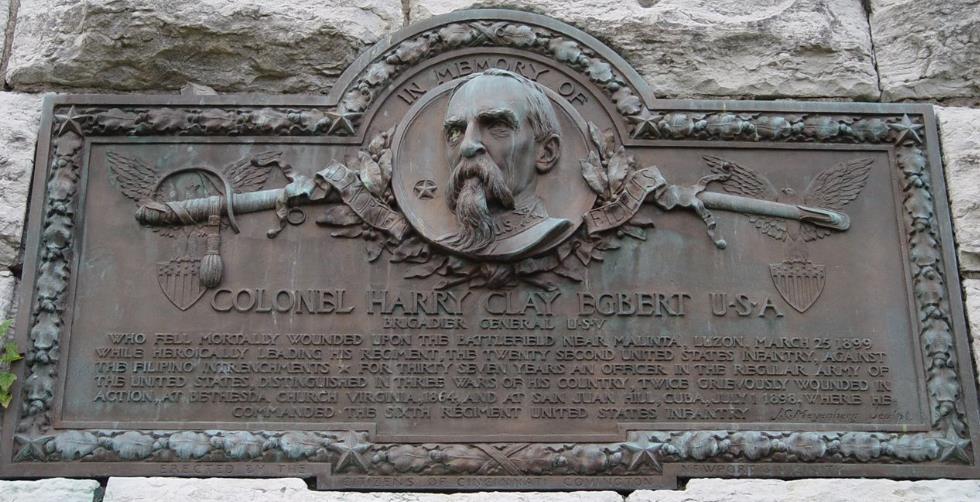
Photo of the memorial plaque for
Colonel Egbert on the Stone Water Tower at Ft. Thomas
The memorial plaque reads:
IN MEMORY OF
COLONEL HARRY CLAY
EGBERT, US-A
BRIGADIER GENERAL U-S-V
WHO FELL MORTALLY WOUNDED UPON THE BATTLEFIELD NEAR MALINTA,
LUZON, MARCH 25 1899
WHILE HEROICALLY LEADING HIS REGIMENT, THE TWENTY SECOND UNITED
STATES INFANTRY, AGAINST
THE FILIPINO ENTRENCHMENTS * FOR THIRTY SEVEN YEARS AN OFFICER IN
THE REGULAR ARMY OF
THE UNITED STATES, DISTINGUISHED IN THREE WARS OF HIS COUNTRY,
TWICE GRIEVOUSLY WOUNDED IN
ACTION, AT BETHESDA CHURCH VIRGINIA, 1864, AND AT SAN JUAN HILL,
CUBA, JULY 1 1898, WHERE HE
COMMANDED THE SIXTH REGIMENT UNITED STATES INFANTRY.
ERECTED BY THE CITIZENS OF CINNCINNATI COVINGTON NEWPORT & VICINITY
The bronze plaque of Egbert was
sculpted by John C. Meyenberg and was dedicated July 8, 1899.
The plaque is officially registered in the Art Inventories
Catalog, Smithsonian American Art Museums.
|
Close-up of Egbert's plaque Note the 22nd Infantry insignia on his collar. |
View of the water tower showing
the large plaque for the Photo from Entertaining View from Cincinnati |
Side view of the tower Photo from the Apex Realty Group |
**********************
Egbert Barrack, at Fort McClellan, Alabama, is named in honor of Harry C. Egbert.
Phillip Tutor: At McClellan, meet Col. Egbert
May 23, 2013
To find Harry Clay Egbert at McClellan, drive over to the
three-story building that sits across the road from Silver
Chapel. Find the main door,
the one that faces Buckner Center. Look up, through the limbs of
pine trees and climbing vines.
There you’ll find H.C.
This Memorial Day weekend, H.C. Egbert lives on at
Anniston’s former Army post.
The brass plaque affixed to his building — Building No. 144,
it’s called — dubbed it Egbert Barrack when soldiers
still lived on post. After nearly 15 years
of base closure and McClellan redevelopment, Egbert’s plaque
reminds us that these acres of Alabama land wield a history that
is as vast as it is varied.
Fitting, it is, that Egbert’s plaque sits hidden, almost out
of view. He isn’t buried in McClellan’s military
cemetery. He never visited Fort McClellan.
He had nothing to do with the post’s creation. He was
neither a Southerner nor an Alabamian. But his plaque, which, I
am thankful, hasn’t been vandalized
or innocently lost, is worth a lesson on this man who was a
quintessential American soldier of his time.
Born in Philadelphia, H.C. joined the 12th U.S. Infantry in 1861.
His list of battles reads like a John Keegan textbook: Gaines
Mills, Malvern Hill,
Cedar Mountain, Gettysburg. Confederates wounded him once and
twice took him prisoner. After the war, he remained in uniform,
serving at several
outposts in the American West, from Arizona to Alaska. He
commanded units that fought against the Sioux.
Discharged as a brigadier general of the U.S. Volunteers in 1898,
H.C. became a lieutenant colonel in time to command the 6th U.S.
Infantry during the
Spanish-American War in Cuba. There, on a July day on San Juan
Hill, he took a bullet “through his body,” records
show. He survived.
The next spring, and now a colonel, H.C. sailed to the
Philippines, where America’s turn-of-the-century venture in
colonialism rolled on.
He landed in Manila on March 4, 1899. Twenty-two days later, he
died during a battle with Filipino insurgents.
The Army returned his body to the United States.
He’s buried at Arlington National Cemetery.
It’s no surprise, really, that memorials to his legacy dot
the American map.
In San Francisco, Egbert Avenue runs for three blocks just
northwest of Candlestick Park.
In Eagle, Alaska, near the Canadian border, sit the remnants of
Fort Egbert, which President William McKinley established the
same year H.C. died.
In northern Kentucky in Fort Thomas, just across the Ohio River
from Cincinnati, a 102-foot stone water tower reaches to the sky.
Affixed to the tower is a bronze plaque that memorializes H.C.
In the early 1900s in Newport, Ky., the Lansdale Cigar Co.
produced “Colonel Egbert Cigars” and packaged them in a
box adorned
with his photograph and paintings of him leading troops in Cuba.
Fort McClellan’s Egbert plaque isn’t as large or ornate
as the stone tower plaque in Kentucky, it’s not part of the
National Park Service
like the Fort Egbert remants in Alaska, and it’s not as
secure as the avenue in San Francisco.
But it is McClellan’s, which makes it ours.
It says, “EGBERT BARRACK, Named in Honor of COLONEL H.C.
EGBERT, Brigadier General, U.S.V., who commanded the 22nd
Infantry
from July 1, 1898, to March 26, 1899, when he was killed leading
his regiment in the attack on Malinta during the Malolos
Expedition of the Philippine Insurrection.”
As Fort McClellan methodically transforms from a deserted Army
post into a 21st-century economic engine, H.C. Egbert and those
like him deserve protection.
I can’t help but wonder how many other McClellan namesakes
have been lost over time. There is no official McClellan museum,
a secure place open to public view.
It’s a shame.
Yet, Harry Clay Egbert, bronze, weathered, partially obscured, is
as much a part of McClellan’s past as the soldiers who
served there.
This is his weekend. Monday is his day, again.
Phillip Tutor — ptutor@annistonstar.com — is The
Star’s commentary editor. Follow him at
Twitter.com/PTutor_Star.
From The Anniston Star
**********************
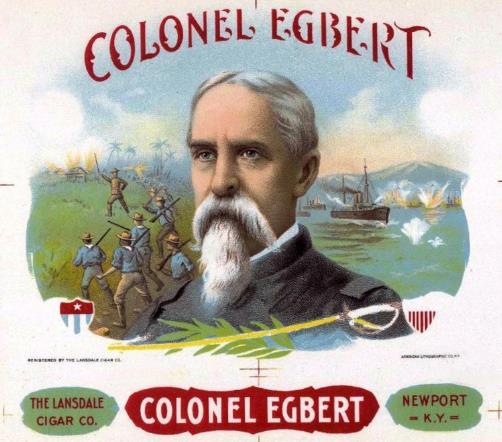
Cigar box label from Colonel Egbert
cigars with Spanish American War motif.
Cigars were made in Newport, Kentucky, only four miles from Fort
Thomas,
where the stone tower with Egbert's plaque is.
**********************
In 2012, a cannon inscribed as a
memorial to Colonel Egbert was un-earthed in the Philippines.
For a report on that cannon click on the following link to go to
that page on this website:
Memorial Cannon for 22nd Commander Found in the Philippines
**********************
1 Illustration of Egbert as a Colonel and
Commander of the 22nd Infantry.
Note the 22nd Infantry Officer's Insignia on his collar.
"The Cost of a Year of War" by Jerome C. Bull,
Munsey's Magazine VOL XXI No. 3, June 1899
2 Powell's Records of Living
Officers of the United States Army by William H. Powell,
Major, 22d Infantry U.S.A.
L.R. Hamersly & Co., Philadelphia 1890
3 COMBAT DIARY Episodes from the History of the Twenty-second Regiment, 1866-1905 by A. B. Feuer, Praeger Publishing, New York 1991
4 Annual Reports of the War
Department for the Fiscal Year Ended June 30, 1899
Government Printing Office, Washington 1899
5 AGUINALDO - A Narrative of Filipino Ambitions by Edwin Wildman, Lothrop Publishing Company, Boston 1901
6 Annual Reports of the War
Department for the Fiscal Year Ended June 30, 1899
Government Printing Office, Washington 1899
7 Photo of
Egbert as a Brigadier General of Volunteers
HISTORY OF THE Twenty-first U.S. Infantry From 1812 to 1863
by Captain Celwyn E. Hampton, The Edward T. Miller Co., Columbus,
Ohio 1911
8 Annual Report of the Secretary of War for the year 1878, Washington, Government Printing Ofice 1878
9 "The Cost of a Year of War" by Jerome C. Bull, Munsey's Magazine VOL XXI No. 3, June 1899
10 University of Pennsylvania: Its
History, Influence, Equipment and Characteristics; with
Biographical Sketches and Portraits of Founders,
Benefactors, Officers and Alumni, Author Joshua Lawrence
Chamberlain, Editors Edward Potts Cheyney, Ellis Paxson
Oberholtzer
Publisher R. Herndon Company, Boston 1902
Home | Photos | Battles & History | Current |
Rosters & Reports | Medal of Honor | Killed
in Action |
Personnel Locator | Commanders | Station
List | Campaigns |
Honors | Insignia & Memorabilia | 4-42
Artillery | Taps |
What's New | Editorial | Links |